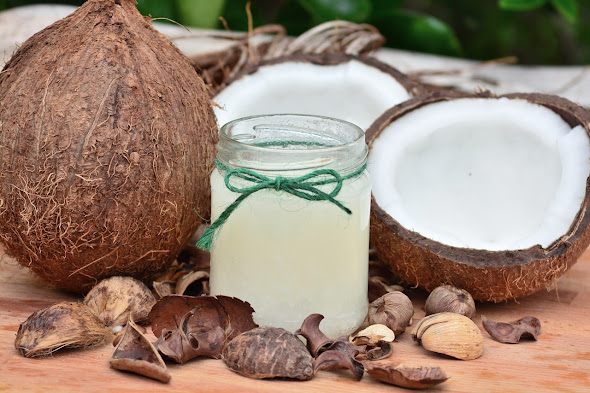Having the
largest plantation area of coconut trees, Indonesia still has a lot of
potential to fulfill the rising demand of coconut and coconut products around
the world. In the matter of quantity, Indonesia ranks first amongst the
producing countries in the world, replacing Brazil since 2011. In the matter of
quality, Indonesia has what it takes to give the best, from soil, climate, and
all the necessities to grow this “tree of life”.
This
amazing plant has been one of Indonesian strategic commodities to be developed.
It is very efficient for product diversification and it is also a main source
for many household, especially in rural area. So, it promotes rural
development, sustainable farming, and healthy consumers.
Nowadays,
even though with huge domestic consumption, Indonesia is still one of the main
player in the export market of coconut and coconut products, just after
Philippines.
Export News
this February Edition will discuss about Indonesian export of coconut and
coconut products, starts from the market review, glimpse of product review,
export development as well as important information to assist readers whom want
to source coconut and coconut products from Indonesia. This edition also
contain exporters list for coconut and coconut products.
Introducing
Indonesian Various Coconut Products
The trend
of consuming healthier food has been a benefit to coconut and its derivatives.
Although the biggest export market are still coconut oil and desiccated
coconut, there are many kinds of Indonesian coconut products that has the
potentials to supply the world needs. Here are some of the trending coconut
products.
1) Coconut
Shell
Coconut
shell is the sturdiest piece which covering the coconut fruit. It serves as the
shield layer between the coconut flesh and coconut husk. The shell is naturally
exist to protect the inner part of the coconut fruit. There are at least two
utilities of this shell. It could be used as charcoal and also for appliances
like handicraft and cutlery.
Coconut
shell charcoal is another derivative product from coconut tree that has a lots
of utilities and benefits. It is widely used as an efficient industrial fuel
and also used to produce activated carbon for many industrial and beauty
applications. For cooking fuel, it is preferred due to its pleasant smell.
Since coconut shell charcoal got the capacity to absorb molecular species it is
widely used for purification purposes also. Coconut shell charcoal in
particular is far better than other charcoals, and the one originated from
Indonesia is better than other origin due to its long burn and low ash.
Besides
charcoal, this shell is used to produce various handicraft and other
appliances. Coconut shell has the superiority due to their strength. The strong
form of this shell is ideal to create handicrafts and these handicrafts keep
for longer time period due to the strength of coconut shell. There is a huge
demand for these types of natural handicraft in all over the world. Cutlery
made from coconut shell
Coconut Oil
Virgin
Coconut oil is made of pure fresh coconut. Not using copra (dried coconut
flesh) as the raw material made VCO is highly nutritive, but at the same time
higher production cost and higher price compared to refined coconut oil. VCO is
used for healthy reason, for food production and as cosmetics.
The coconut oil bad image because of the US negative campaign is slowly
diminished, as it raised fame from early 2004 in Indonesia and the trend
penetrated other producing countries like Philippines and India.
Coconut
sugar is natural sugar which created out of the sap of coconut tree. This
product has the main advantage of lower fructose compared to cane sugar. It
substitutes cane sugar for diabetic patients. It also has a unique taste and
aroma. Lately, coconut sugar gain more popularity in the west due to its
advantages.
The Coconut
Shell ash can be used for the partial replacement of cement. Furthermore, the
use of this value added material may reduce the consumption of cement and in
turn can lessen the impact of CO2 emission.
Coconut
milk, different than coconut water, is the concentrate liquid from coconut
flesh/meat. It is mainly used for cooking like curry, and also a much more
healthy alternative to dairy products like milk. Coconut milk has lower fat
content and also free from lactose. It is also used for beauty industry
Aside from all those products, there are still
some other products derived from coconut, like coconut coir, coconut water,
nata de coco, or even vinegar.
Who doesn’t know coconut? This so called “the tree of life” has so many usefulness. Almost every part of it, from its leaves, trunks, roots, even more the fruit can be made into something useful. From the perspective of product diversification, coconut is might be one of the most productive and efficient plant on earth. The value of this tree has already known long ago in Indonesia. As an example the coconut seeds is used as the symbol of scout, resembling how versatile it is. In
addition to the usefulness, there are some advantages from growing coconut
tree. From the production side, coconut tree can be grown easily in their
suitable habitat. It is also fast growing. Crops yield in the eight years of
plant age. In the coastal area, coconut tree is one of the main source of
income, especially for copra (high oil content of the endosperm) sale, which is
widely used in both food and non-food industries. It is the commodity that has
potentials to develop the rural economy.
Coconut
trees are grown in tropical countries, cultivated in around 93 countries in the
world. Around 82% of global coconut production is originally come from Asia and
Pacific consisting of twelve producing countries, the rest are countries in
Africa and South America. Large production areas, in particular, are found
along the coastal regions in the wet tropical areas of Asia in the Philippines,
Indonesia, India, Sri Lanka and Malaysia. According to Wordlatlas.com, Brazil
was the top coconut producing country up to 2010, but currently, 90% of world
supply originates from Asia, with three Asian producers have bettered it to
take away Brazil’s position, namely Indonesia, Philippines and India. By far,
Indonesia has the largest area of coconut plantation in the world. It’s no
wonder. The soil, climate, height and other necessity to grow the plant are
just suitable. This is placed Indonesia as the top coconut producing country in
the world
This world’s archipelagic country, Indonesia has costal along it’s islands, argillaceous soil and soil rich with organic matter such as mountain ash, which are best for coconut growth and higher yield. And so, all over the country produce coconut. According to Statistics of Indonesia (BPS), national plantation for coconut in Indonesia reached almost 3,7 million hectare. The highest contributor is Riau in Sumatera Island, with almost 15% of national plantation area for coconut tree. The other top nine are : East Java (8,1%); North Sulawesi (7,6%); Central Java (6,4%); Central Sulawesi (5,9%); North Maluku (5,8%); East Java (5%); East Nusa Tenggara (4,2%); Lampung (3,4%) and Jambi (3,2%). The yield map tells almost the same, with the top tree are Riau (13,8%); Sulawesi Utara (9,3%) and East Java (9%).
Besides the
quantity, Indonesia is known as a country placed in tropical area which enables
the coconut trees to plant and grows well.
Therefore,
it is very reasonable if the coconuts produced tend to be in higher quality
compared with other areas. One of the importer of coconut charcoal have the
opportunity to gave testimony in the occasion of Trade Expo Indonesia 2016 that
Indonesian coconut shell, particularly which is originated from Sulawesi
Island, is the best quality in the world.
Despite the versatility, generally, copra and
commercial coconut oil production continue to dominate the industry’s
processing sector in Indonesia. The coconut production is largely the domain of
small poor farmers, which account more than 90% of plantation area. They plant
coconut mainly for copra sale. According to APCC (Asian and Pacific Coconut
Community), as it describes in graph 1, coconut oil is the largest export
volume, accounts 40% of total coconut and its derivative products. Besides oil,
desiccated coconut as a product derived from fresh coconut ranked second at
national level in terms of its contribution to the coconut industry’s total
export value.

To get the
idea of how Indonesian coconut and coconut products provide the world need, we
can use the approach of global supply and demand. Coconut oil and . Coconut
meat are the most valuable traded coconut products. Traded under the HS code of
151311-19 (coconut oil), and under the HS code of 080111-19 (coconut meat)1,
the two products make the biggest share based on word import value for coconut
and coconut products. From this point of view, Indonesia plays its role to
fulfill the biggest market of coconut products, so Indonesia’s export of
coconut products responsive to the import demand.
Basically
the world top exporter for coconut oil can be devided to three groups,
Philippines, Indonesia and rest of the world2. The average of Indonesian share
to world export was 29,21% each year in periode 2011-2015, while Philippines
ranked first with 41,76% and rest of the world with 29%. That made those two
countries made a combined of around 70% of world export value. As the supplier
for coconut oil is dominated by Philippines and Indonesia, the world value of
export was reflected from the two countries trend.


When the
price of coconut oil rises or falls, the price of desiccated coconut (as the
largest share of Indonesian coconut meat products export)3 will soon follow and
vice versa. This could be happened since they compete for the same raw material
— raw coconut. So, the price of desiccated coconut closely follows the price of
coconut oil.

But the
coconut oil prices rebound and have a positive trend during the 2016 period
(Picture 4). There has to do something with the fact that the demand side
brings other impacts. In practical life, the trend of consuming coconut
products are on the rise. Coconut and coconut products has gaining more and
more popularity in last few years. They can be found in the natural food stall
or organic market, etc, and therefore have raised the image as healthy,
sustainable, premium products. It seems that the consumer demand for coconut
and coconut products is still going to a positive trend in the near future and
in the normal condition, the prices wouldn’t likely to drop significantly in
the same near future.
However, the condition of supply side is on shortage. The supply might wouldn’t satisfy the rising demand. One of the main reason should be the coconut trees are old. In most producing countries, they have left their primary age of high yield. Other reasons might be the market for coconut products which are competing from its raw material. For example the coconut water. Rising demand for coconut water may cause the coconut fruit to be harvested earlier and the raw material for coconut oil will be in lacking somehow. This issue has been taken into concern and priority matter by the Government of Indonesia. According to the Ministry of Agriculture Republic of Indonesia, replanting coconut trees will be done this year inasmuch as 16.725 hectares in 20 producing provinces. Improving the cropping systems is also part of the national agenda, since coconut is one of the strategic commodity of Indonesia to be put in one of the priorities. In addition, regarding to the geographical indication, kopyor (a premium species of coconut with high productivity and high frequency of bearing fruit) was also developed in some provinces and tourist attraction.
So,
alongside with the land advantage that Indonesia has, the quantity and the
quality of Indonesian products is on guarantee. Therefore, along with
huge opportunity to develop, sourcing coconut products from Indonesia would be
the best choice now and then.
Source : Here



.jpg)







.png)















